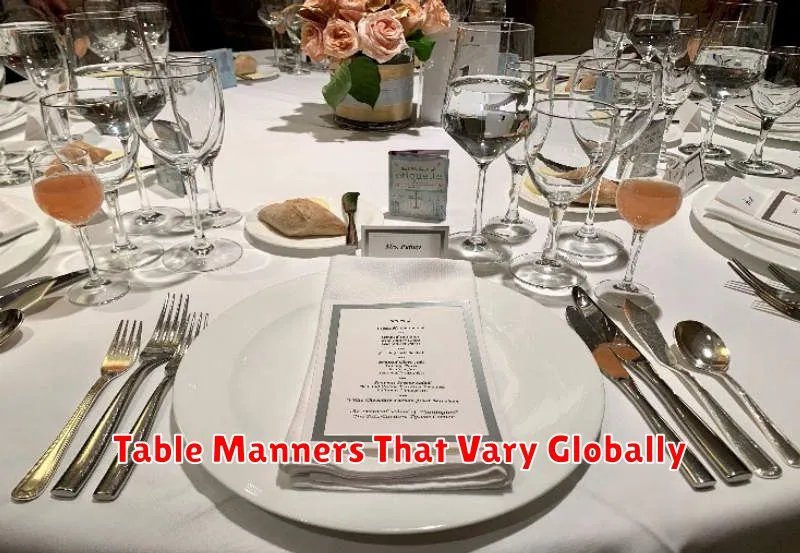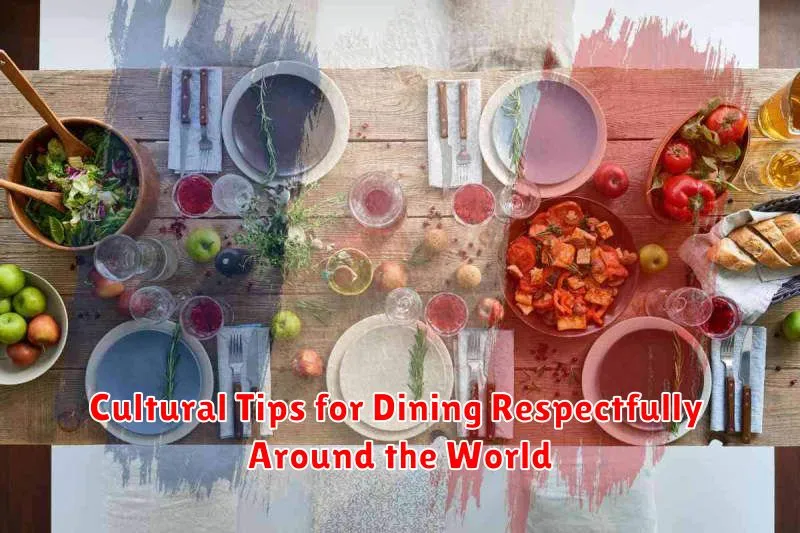Navigating the diverse culinary landscape of our world offers an incredible opportunity to experience different flavors and traditions. However, alongside the excitement of exploring new cuisines comes the responsibility of understanding and respecting the cultural norms surrounding dining etiquette. From chopstick mastery in Japan to proper handwashing rituals in India, dining respectfully transcends mere consumption and becomes a profound display of cultural sensitivity. This article delves into the essential cultural tips for dining around the world, empowering you to embrace local customs with grace and appreciation. Learn how to approach different dining scenarios, from formal settings to casual meals, ensuring you leave a positive impression wherever your culinary adventures take you. Mastering the art of respectful dining not only enhances your personal experiences but also fosters cross-cultural understanding and connection.
Embark on a journey of culinary exploration as we uncover a world of dining etiquette. Discover how seemingly small gestures can make a significant impact when dining around the world. Whether you’re a seasoned traveler or simply curious about other cultural norms, understanding proper dining respectfully practices is crucial. From the significance of shared plates in some cultures to the specific uses of cutlery in others, this guide will equip you with the knowledge you need to navigate a variety of dining situations with confidence and respect. Join us as we explore these essential cultural tips and unlock a deeper understanding of global dining etiquette.
Why Dining Customs Matter
Understanding and respecting dining customs is crucial for navigating social situations gracefully while traveling or interacting with people from different cultural backgrounds. Observing proper etiquette demonstrates respect and cultural sensitivity, fostering positive relationships and avoiding misunderstandings.
Table manners can vary significantly across cultures. What might be considered polite in one country could be seen as rude or offensive in another. For example, using the wrong hand to eat or failing to acknowledge the host properly could create a negative first impression. By being mindful of these customs, you show that you value the other culture and are willing to make an effort to fit in.
Proper dining etiquette can also contribute to a more enjoyable and harmonious dining experience for everyone involved. When everyone adheres to cultural norms, the meal becomes a shared experience that promotes connection and understanding. This is particularly important in business settings, where respecting local customs can build trust and pave the way for successful collaborations.
When and How to Tip

Tipping customs vary significantly around the world. In some cultures, tipping is deeply ingrained, while in others, it may be considered offensive. Understanding these nuances is crucial for respectful dining.
In the United States, tipping is generally expected in restaurants, bars, and for services like taxis and haircuts. A typical tip for good service in a restaurant is between 15% and 20% of the pre-tax bill. For exceptional service, a higher tip is appropriate. In bars, $1-2 per drink is customary, or 15-20% of the total tab.
Many European countries include a service charge in the bill. While additional tipping is not always required, it is often appreciated for excellent service. A small tip, around 5-10% is usually sufficient. In some Asian countries, such as Japan and China, tipping is not customary and may even be considered rude. However, in other parts of Asia, like India and Southeast Asia, tipping is becoming more common, particularly in tourist areas.
Always research the local customs before you travel. This will prevent awkward situations and ensure you are showing respect for the local culture. When in doubt, it is always polite to ask your server or hotel concierge about appropriate tipping practices.
Table Manners That Vary Globally

Understanding dining etiquette worldwide is crucial for demonstrating respect and cultural sensitivity. While some table manners are universally appreciated, others vary significantly. Being mindful of these differences can greatly enhance your dining experiences abroad.
In some cultures, like Japan, it’s considered polite to slurp your noodles, indicating enjoyment of the meal. Conversely, in many Western cultures, slurping is generally frowned upon. Using utensils also differs globally. While forks and knives are common in the West, chopsticks are prevalent in many Asian countries, and eating with your hands is customary in parts of Africa and the Middle East. Knowing the appropriate utensil etiquette is essential.
Another key aspect is how you handle bread. In some cultures, tearing bread is preferred over cutting it with a knife. Additionally, the placement of your hands during a meal can convey different messages. In some cultures, keeping your hands visible on the table is expected, while in others, resting your hands in your lap is the norm. Being aware of these subtleties can make a significant difference in how you are perceived.
Finally, the act of finishing all the food on your plate carries different meanings across cultures. In some, a clean plate signals satisfaction and appreciation to the host, whereas in others, it might imply that you are still hungry. Being mindful of these cultural nuances can help you navigate dining situations with grace and respect.
Respecting Food and Meal Timing
Meal times and food itself are often treated with a great deal of respect in many cultures. Being mindful of these customs can demonstrate your cultural sensitivity.
In some cultures, it’s considered impolite to begin eating before everyone is served or before a prayer or blessing is given. Observe what others are doing and follow their lead. Similarly, in some cultures, finishing all the food on your plate is a sign of appreciation, while in others, it might signal that you’re still hungry. Researching these customs beforehand can prevent unintentional misunderstandings.
Punctuality is also a key factor. Arriving on time for a meal demonstrates respect for your host and their schedule. If you anticipate being late, it’s courteous to inform them in advance. Conversely, in some cultures, arriving a little late is the norm, so understanding the specific cultural context is crucial.
The way food is handled also varies across cultures. Using the correct utensils, or eating with your hands when appropriate, shows respect for local traditions. In some cultures, it’s considered rude to use your left hand for eating, while in others, it’s perfectly acceptable. Being aware of these nuances can help you navigate dining situations gracefully.
When to Accept or Decline Food Politely
Navigating food offerings in unfamiliar cultures can be tricky. Accepting food is often seen as a sign of respect and appreciation for the host’s hospitality. In some cultures, refusing food can be considered rude or offensive. Try a small portion, even if you’re unsure. A polite compliment about the food’s appearance or aroma can go a long way.
However, there are valid reasons for declining food politely. Allergies, dietary restrictions, or religious observances are all acceptable reasons. Express your gratitude for the offer and briefly explain your reason for declining. Sincerity and a respectful tone are crucial. A simple “Thank you so much, but I’m unable to have that due to a [reason]” is usually sufficient.
Observe the host and other guests. In some cultures, refusing the first offer is customary, and the host will insist a second or third time. Pay attention to these cues and follow the lead of others at the table. In other cultures, the first refusal is taken literally. Being mindful of these cultural nuances will demonstrate your respect and cultural sensitivity.
How to Order the Right Way
Ordering correctly demonstrates respect for local customs. In some cultures, it’s polite to allow the host or the most senior person at the table to order first. Observe and follow their lead if you’re unsure.
Be mindful of portion sizes. In some countries, ordering too much food can be seen as wasteful, while in others, it signifies abundance and generosity. Researching typical serving sizes beforehand can help you avoid any unintended faux pas.
Pay attention to how locals interact with the waitstaff. In some cultures, direct eye contact and a firm voice are expected, while in others, a more subdued approach is considered polite. Mirroring the behavior of those around you is a good general rule.
Finally, don’t be afraid to ask questions. If you’re unsure about an ingredient or dish, politely inquire with your server. Most restaurants are happy to explain their menu and accommodate dietary restrictions or preferences. Clear communication can prevent misunderstandings and ensure a pleasant dining experience.
Avoiding Embarrassing Faux Pas
Dining etiquette varies significantly across cultures. Understanding and respecting these differences is crucial for making a positive impression and showing respect to your hosts. A seemingly innocuous gesture in one country can be considered a grave insult in another. Researching the specific customs of your destination before you travel is essential.
Common faux pas include using the wrong hand for eating, leaving chopsticks upright in a bowl of rice, or talking with your mouth full. Be mindful of table manners like proper utensil usage and appropriate conversation topics. In some cultures, it’s polite to finish all the food on your plate, while in others, leaving a small amount shows you’ve had enough.
Observe your hosts and fellow diners. Imitating their behavior is often the safest approach, especially when you’re unsure of the proper protocol. Don’t be afraid to ask questions if you’re unsure about something. Most people appreciate the effort you’re making to respect their customs.

